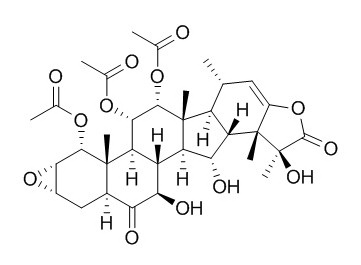Taccalonolide B
Taccalonolide B displays microtubule stabilizing activity.Several taccalonolides have in vitro antitrypanosomal activity against Trypanosoma brucei brucei and EC50 values for the isolated compounds were from 0.79 ug/mL.
Inquire / Order:
manager@chemfaces.com
Technical Inquiries:
service@chemfaces.com
Tel:
+86-27-84237783
Fax:
+86-27-84254680
Address:
1 Building, No. 83, CheCheng Rd., Wuhan Economic and Technological Development Zone, Wuhan, Hubei 430056, PRC
Providing storage is as stated on the product vial and the vial is kept tightly sealed, the product can be stored for up to
24 months(2-8C).
Wherever possible, you should prepare and use solutions on the same day. However, if you need to make up stock solutions in advance, we recommend that you store the solution as aliquots in tightly sealed vials at -20C. Generally, these will be useable for up to two weeks. Before use, and prior to opening the vial we recommend that you allow your product to equilibrate to room temperature for at least 1 hour.
Need more advice on solubility, usage and handling? Please email to: service@chemfaces.com
The packaging of the product may have turned upside down during transportation, resulting in the natural compounds adhering to the neck or cap of the vial. take the vial out of its packaging and gently shake to let the compounds fall to the bottom of the vial. for liquid products, centrifuge at 200-500 RPM to gather the liquid at the bottom of the vial. try to avoid loss or contamination during handling.
J Bone Miner Res.2017, 32(12):2415-2430
Nutraceutical Research . 2021, 19(1),p90-105.
J Biol Chem.2021, 297(6):101362.
J Med Assoc Thai2024, P-04.
Front Nutr.2024, 11:1409309.
Expert Opin Ther Targets.2024, :1-11.
Biomedicines.2022, 10(2):463.
Phytochem Anal.2022, doi: 10.1002
ACS Omega2020, 5,33,20825-20830
Sci Rep.2019, 9(1):18080
Related and Featured Products
J. Am. Chem. Soc., 2011, 133 (47), pp 19064–19067
Potent Taccalonolides, AF and AJ, Inform Significant Structure–Activity Relationships and Tubulin as the Binding Site of These Microtubule Stabilizers[Reference:
WebLink]
The taccalonolides are a class of microtubule stabilizing agents isolated from plants of the genus Tacca. In efforts to define their structure–activity relationships, we isolated five new taccalonolides, AC–AF and H2, from one fraction of an ethanol extract of Tacca plantaginea.
METHODS AND RESULTS:
The structures were elucidated using a combination of spectroscopic methods, including 1D and 2D NMR and HR-ESI-MS. Taccalonolide AJ, an epoxidation product of Taccalonolide B, was generated by semisynthesis. Five of these taccalonolides demonstrated cellular microtubule-stabilizing activities and antiproliferative actions against cancer cells, with taccalonolide AJ exhibiting the highest potency with an IC50 value of 4.2 nM. The range of potencies of these compounds, from 4.2 nM to >50 μM, for the first time provides the opportunity to identify specific structural moieties crucial for potent biological activities as well as those that impede optimal cellular effects. In mechanistic assays, taccalonolides AF and AJ stimulated the polymerization of purified tubulin, an activity that had not previously been observed for taccalonolides A and B, providing the first evidence that this class of microtubule stabilizers can interact directly with tubulin/microtubules. Taccalonolides AF and AJ were able to enhance tubulin polymerization to the same extent as paclitaxel but exhibited a distinct kinetic profile, suggesting a distinct binding mode or the possibility of a new binding site.
CONCLUSIONS:
The potencies of taccalonolides AF and AJ and their direct interaction with tubulin, together with the previous excellent in vivo antitumor activity of this class, reveal the potential of the taccalonolides as new anticancer agents.



